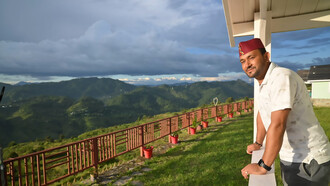Yogyakarta is the heart of Javanese culture, rich in historical heritage and artistic expression. The city is known for its natural beauty, warm hospitality, and many treasured relics that trace the long journey of Javanese history and tradition. On this visit, I explored two museums that reflect the depth of that heritage: the Sonobudoyo Museum and the History of Java Museum. Though different in approach, both museums offer unique perspectives on the evolution of Javanese history, art, and culture. Each stands as a silent witness to the enduring development of Javanese identity in Indonesia.
Sonobudoyo Museum
My first stop was the Sonobudoyo Museum, a place that has held a special place in my heart since my first trip to Yogyakarta. Conveniently located near the city’s North Square, it’s easily accessible for visitors interested in learning more about Javanese culture and history. The entrance fee was modest—only Rp10,000—which allowed me to explore the museum thoroughly and at my own pace.
The Sonobudoyo Museum is one of the most significant cultural institutions in Yogyakarta. Founded in 1935 and inaugurated by Sri Sultan Hamengkubuwono VIII, it houses a remarkable collection that documents Javanese history and culture. The building itself is a tribute to traditional Javanese architecture, featuring the elegant and iconic pendopo (gazebo) style.
Crossing the museum’s threshold, I immediately felt a sense of reverence. The air was heavy with history. As I wandered through hallway after hallway, I was captivated by the richness of Javanese life in the past. Each floor revealed a different chapter of the region’s evolution—the higher I climbed, the more the displays shifted toward the modern era.
The museum is home to around 43,000 artifacts across various disciplines, including archaeology, ethnography, numismatics, ceramics, and fine arts. Its collections include an impressive array of kris daggers, puppets, and batik textiles from different regions, as well as inscriptions, Hindu-Buddhist statues, and more. These items together trace the intricate development of Javanese culture through time. On certain evenings, the museum also hosts cultural performances, inviting visitors to experience and help preserve traditional art forms. Unfortunately, I didn’t have the chance to witness one due to time constraints—but it gives me a good reason to return.
History of Java Museum
From there, I continued to the History of Java Museum, located on Jalan Parangtritis KM 5.5. Unlike the traditional Sonobudoyo Museum, this one blends Javanese heritage with cutting-edge technology, offering an interactive and contemporary take on historical education. It was this innovative approach that drew me in. Established in 2018, the History of Java Museum presents Javanese culture using modern tools like Augmented Reality (AR) and Virtual Reality (VR). This made the experience not just informative, but also engaging and fun.
Upon arrival, I was guided to a theater room where a video introduced the origins of Javanese civilization. The museum has four main sections: the theater room, a collection room, a 3D room, and a diorama room. After the video, I entered the second room, where artifacts were displayed alongside AR features, allowing me to view the relics in high-definition detail.
In the third room, I enjoyed a vivid 3D video that brought Javanese history to life in a fresh and dynamic way. Finally, in the diorama room, visitors could take photos with various scenic backdrops, and even dress up in traditional kebaya costumes—an especially charming touch.
These two museums highlight distinct aspects of Javanese cultural preservation. While the Sonobudoyo Museum focuses on tangible history and conventional collections, the History of Java Museum emphasizes interactivity and technology to connect with a new generation. I found both to be equally valuable. The Sonobudoyo Museum is perfect for those who want to see authentic historical artifacts up close, while the History of Java Museum appeals to those seeking a more modern, immersive learning experience.
Together, they offer a comprehensive and enriching way to explore the past and present of Javanese culture. Visiting them brought back memories of school days spent learning history and deepened my appreciation for Indonesia’s cultural richness.
Exploring these two iconic museums in Yogyakarta expanded my understanding of Javanese civilization—from ancient times to the contemporary era—and reaffirmed my admiration for our nation’s heritage. The experience concluded my trip on a high note, reminding me of the importance of preserving the culture our ancestors built so that future generations may continue to experience and cherish it.















